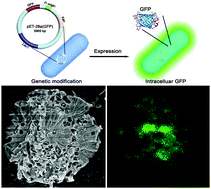Particle-attachment crystallization facilitates the occlusion of micrometer-sized Escherichia coli in calcium carbonate crystals with stable fluorescence†
Abstract
Inspired from the occlusion of macromolecules in mineral crystals during the biomineralization process, the occlusion mechanism of functional guest species into a host matrix is gradually revealed in artificial systems. However, the guest species within calcite crystals are limited to the nanometer scale. Herein, using amorphous calcium carbonate (ACC) as a precursor and taking advantage of the crystallization of vaterite by the attachment of ACC nanoparticles, micrometer-sized modified Escherichia coli (E. coli) was incorporated into vaterite crystals. The occlusion content of bacteria within the vaterite crystal could reach up to 16 wt%. On the contrary, the occlusion of E. coli into calcite crystals, which proceeded via ion-by-ion addition growth, was only confined to the surface layer. Through modifying the surface structure or chemical composition of bacteria, the strong interaction between the surface of the bacteria and calcium carbonate has proved to be the key factor for successful occlusion. Interestingly, the genetically modified green fluorescent protein (GFP)-E. coli/vaterite composites exhibited stable fluorescence for more than six months with little attenuation and the lifetime could be more than 1.2 μs. It was demonstrated that a combination of the amorphous precursor crystallization pathway and a suitable surface structure of the foreign species can significantly enhance the occlusion efficiency of micrometer-sized species in crystals.

- This article is part of the themed collection: Journal of Materials Chemistry B HOT Papers


 Please wait while we load your content...
Please wait while we load your content...